by Larry Williams | Apr 16, 2018
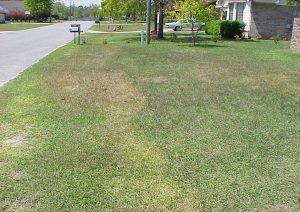
Cold injury to lawn. Photo Credit: Larry Williams
Patience, warmer soil temperature and correct lawn management will solve many spring lawn problems.
Many spring dead spots in lawns are caused by something that happened the previous growing season or winter. For example, a late application of a high-nitrogen fertilizer can decrease winter survival. It’s best to not fertilize our lawns after early September.
An insect or disease problem during fall many times goes unseen as the grass is beginning to go dormant. The following spring, as the lawn begins to green up, evidence of a fall pest is clearly visible by brown dead, grass. The pest may not be present or active during spring.
Poor maintenance practices may be to blame for spring dead spots. Over-watering, shallow watering (watering frequently for short periods), mowing too low, too much fertilizer and herbicide injury can result in poor lawn performance come springtime.
Regardless of cause, problem areas within lawns are slow to recover during spring due to frequent cool night temperatures. Frequent cool nights keep the root zone cool.
Cool soil temperature doesn’t allow rapid root regeneration in spring, which inhibits top growth in your lawn. Cool soil also decreases availability of some needed nutrients. For example, poor availability of iron because of cool soil is a common cause for bright yellow areas within lawns, especially in centipedegrass. Cool soil also decreases availability of phosphorus and potassium, which can result in reddish-purple grass blades, intermingled throughout the yard. As soil temperature increases, availability of nutrients improves and the yellow and purple areas turn green.
Have patience with your lawn and follow good maintenance practices this spring. Provide ½ to 1 inch of water when the grass shows signs of wilt. Fertilize and lime based on the results of a reliable soil test. And, mow at a high setting. Good lawn maintenance info is provided at the YourFloridaLawn website.
Consistently warmer nights will allow the soil temperature to warm, which will improve turf root growth, nutrient availability and lawn recovery. During many years in North Florida, it’s well into the month of May before our lawns begin to recover.
If the lawn has not made a comeback by late spring or early summer, it may be time to consider reworking and replanting the dead areas or maybe consider replacing them with something other than grass, if practical.
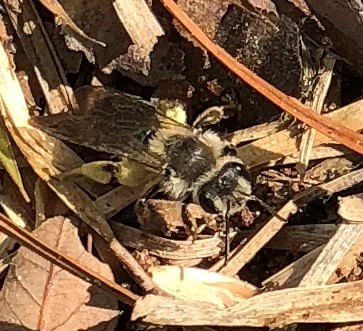
by Molly Jameson | Mar 26, 2018

Digger bees resemble honey bees, although they do not sting, and would only bite if mistreated. Photo by Molly Jameson.
Have you noticed many little dirt piles that resemble mini ant mounds around your yard? Well, fear not, for these mini mounds are made by digger bees who are excellent, yet ephemeral, early-spring pollinators.
These solitary ground-nesters are native to our area and only appear for four to six weeks to raise their offspring. Although they do not produce honey, they resemble honey bees in size and shape. They also do not sting and would only bite if they were handled roughly.
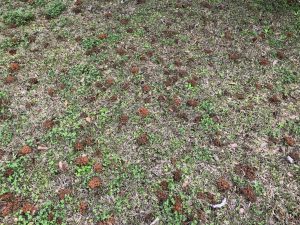
Female digger bees build their nests close together, creating clusters of many small mounds. Photo by Molly Jameson.
Otherwise known as miner bees, females create their underground cylinder-shaped nests in dry, well-drained soils, often right next to each other, creating patches of many mounds in a small area.
These bees will pollinate many early-spring blooming flowers – a bonus for gardeners – as they collect pollen to add to each cell that they excavate. They then lay their eggs on these pollen masses, cap the cells with clay, and complete their life cycles. The eggs hatch about five days later and emerge from the chamber created by their mothers.
While digger bee mounds may detract from an otherwise tidy lawn, they will do no harm, and can actually be beneficial, in that they improve air, water, and nutrient percolation. If you feel you must discourage their presence, simply run a sprinkler over the area as their season approaches. They prefer dry soil rather than wet soil and will look elsewhere to build their nests.
But better yet, take a seat on your front or back porch, pour yourself some lemonade, and take in the soothing hums of their wings as they do their work.
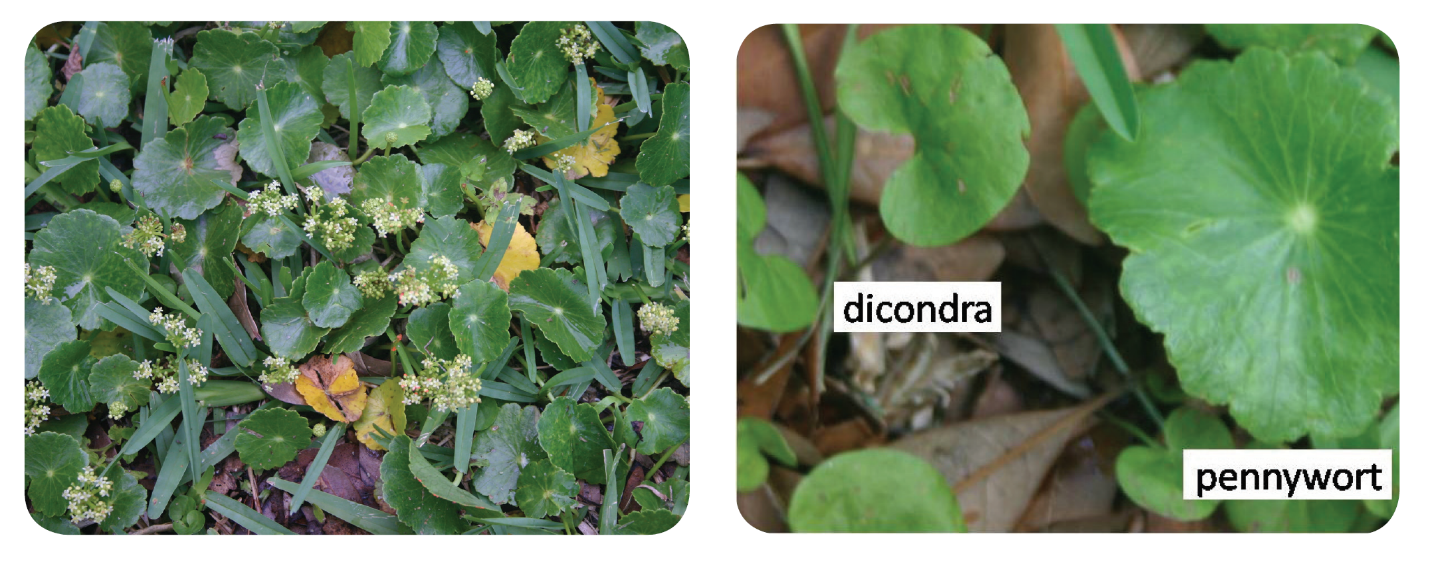
by Ray Bodrey | Feb 5, 2018
We have many weeds in the Panhandle that are a nuisance to our landscape, with some being very difficult to control. Dollarweed certainly falls into this category. But, does dollarweed have an upside?
Dollarweed (Hydrocotyle spp.) is a largeleaf creeping perennial that thrives in central and northern Florida, but is found throughout both Atlantic and Gulf coasts. Dollarweed is resilient, as it can reproduce by seed, rhizomes and tubers. The mature plant produces vertical shoots with shiny green round shaped leaves and scalloped edges. The leaves can grow up to the size of a silver dollar, hence the plant’s name. This plant grows low to the ground and thrives in moist environments.
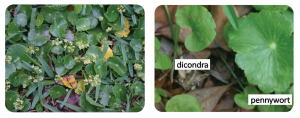
Figure 1: Pennywort (Dollarweed) vs. Dicondra.
Credit: Ramon G. Leon, Darcy E. P. Telenko & J. Bryan Unruh, UF/IFAS
Hydrocotyle umbellate is the species most found in Florida lawns. In city landcsapes, dollarweed can be an indicator of leaking water mains or even septic drainfield problems. It also can be an indicator that you may be over-irrigating your lawn. Hydrocotyle bonarienies or pennywort, on the other hand, is a species that is found on frontal and back dune areas, along with sandy marsh or flatlands. This species is known to help stabilize dunes and assist in combatting dune erosion.
Often, dollarweed is confused with pony’s foot or Dicondra carolinensis. This weed will grow along with dollarweed, as it prefers moist environments as well. Pony’s foot has a distinct difference in leaf structure than dollarweed. Pony’s foot has a kidney-shaped circular leaf, as dollarweed is disc shaped.
How does one control dollarweed in a landscape? Pulling it up by hand can be successful. However, it’s a must to pull all of the white rhizomes from the soil. Otherwise, the plant will rebound quickly. Selective & non-selective herbicides will control dollarweed. However, you must be persistent. Applying a pre-emergent and post emergent herbicide is the best practice when using chemical applications. There are many herbicides on the market that specifically list the control of dollarweed, such as atrazine and 2, 4-D options. Always follow the directions and precautions from the manufacturer when using a herbicide and be sure that the product will not affect your variety of turfgrass. Contact your local county extension office for more information on controlling dollarweed and other pesky weeds.
Supporting information for this article can be found in the following the UF/IFAS publication:
“Pennywort (Dollarweed) Biology and Management in Turf” by Ramon G. Leon, Darcy E. P. Telenko and J. Bryan Unruh: http://edis.ifas.ufl.edu/pdffiles/EP/EP38900.pdf
& “Native Plants for Coastal Dune Restoration- What, When and How for Florida” by M.J. Williams, USDA NRCS: https://www.nrcs.usda.gov/Internet/FSE_PLANTMATERIALS/publications/flpmspu7474.pdf
UF/IFAS Extension is an Equal Opportunity Institution.
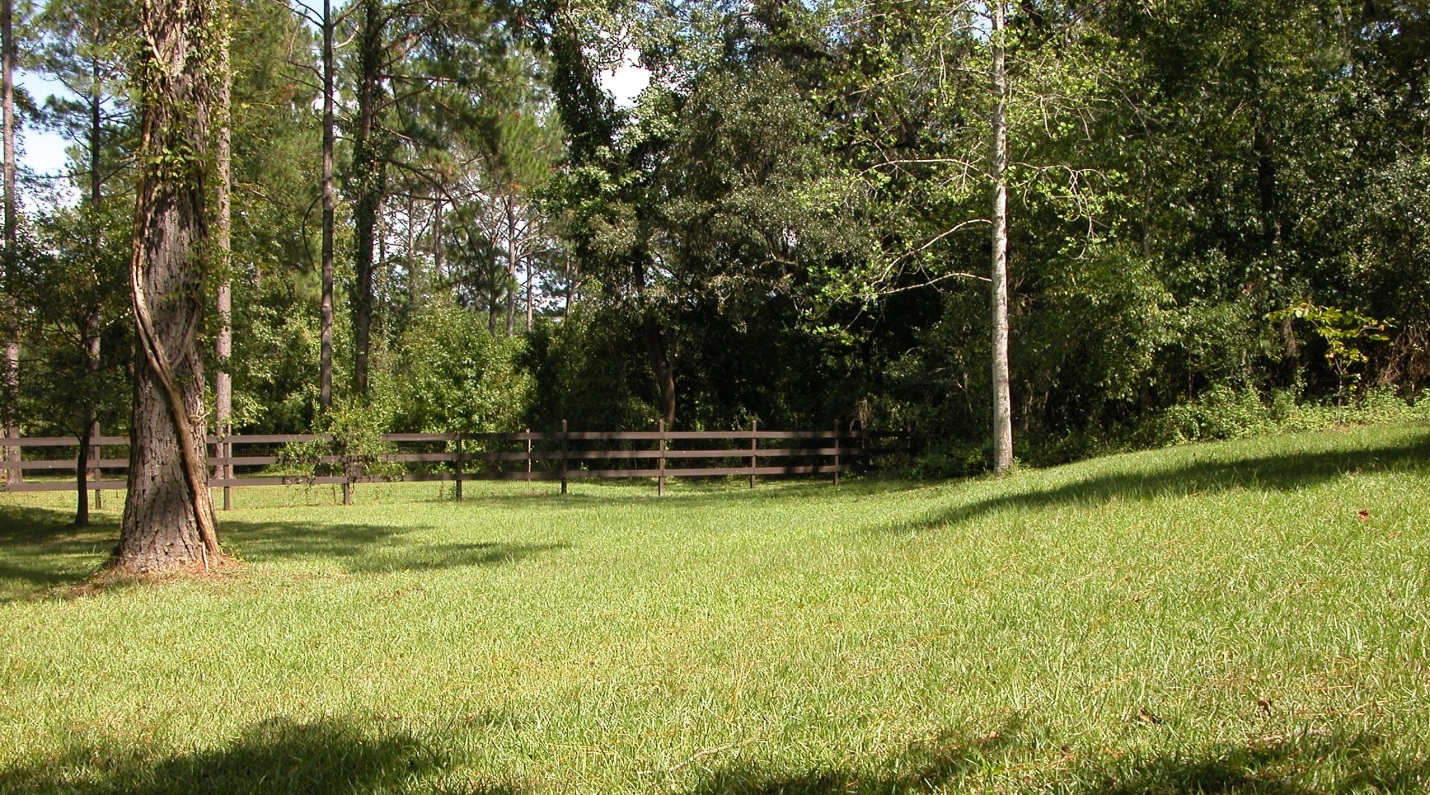
by Mark Tancig | Nov 20, 2017

Proper maintenance all year long is the best way to achieve a healthy lawn. Credit: Jim Stevenson
If you’ve been to a local garden center lately, there’s a good chance you’ve seen some displays marketing winterizer fertilizer for your lawn. Many of these displays are quite shiny and state all sorts of reasons why you should apply fertilizer to prepare your lawn for winter.
However, as with most purchases, a little consumer research is a good idea before being persuaded by those glossy ads. Where do you find such non-biased, evidence-based information on lawn and garden topics in Florida? UF/IFAS Extension, of course!
UF/IFAS research has found that for warm-season grass species used for North Florida lawns, the last application of fertilizer should occur no later than September. Why so? Well, similar to deciduous tree species, our warm-season grasses, including centipede, St. Augustine, bahia, and zoysia, are adapted to go dormant at the onset of cooler weather.
Once the transition into dormancy begins, the turf is not actively growing, therefore nutrient uptake slows down. Eventually, the turf becomes brown and will remain that way until warmer spring temperatures initiate active growth again.
What about all the glossy ad’s claims regarding improved root growth? When looking over the N-P-K values of winterizer fertilizers, you will notice that most have a high third number, indicating a greater proportion of potassium. Research does show that adequate potassium levels do make turf more resilient to stress. However, if the turf has been maintained properly throughout the year – proper mowing height, irrigation, and fertilization – then the lawn’s root systems are likely strong enough to get it through winter.
Winterizer fertilizers that contain a high proportion of nitrogen, say over a 5 on the N-P-K analysis, can actually cause your lawn harm. Nitrogen promotes leaf and shoot growth, which is tender to damage from cold weather. If these type products are applied late in the year, new growth is likely to be nipped by a cold snap, causing stress to the lawn, which can lead to greater pest pressure and poor growth the following spring.
For a healthy lawn, there’s no substitute for year-long good care. If you are having a lawn issue or would like more information on fertilizing lawns, please call your local Extension Office or check out some of UF/IFAS’s online resources!

by Matthew Orwat | Oct 10, 2017

Burweed, Soliva Sessilis. – Image Credit: Joseph M. DiTomaso, University of California – Davis, Bugwood.org. Creative Commons License
On the top of my list of lawn related annoyances is stepping into a patch of burweed, Soliva sessilis, which is in the sunflower family and is also known as spurweed. The leaves are opposite along the stem and sometimes resemble parsley. The main ways in which burweed can irk the casual gardener are sticking to socks, sneaking in with the dog, or littering flower beds with its nuisance. It can also hide in the house and reappear when shoes are removed. This causes pain in both the foot and the ear.
Lawn burweed has been an especially noticeable problem in lawns. Over the years, extension offices throughout Northwest Florida have been fielding many questions and finding solutions to lawn burweed infestations!
Maintaining a healthy vigorous lawn will prevent weeds from taking over. If your lawn is reasonably healthy and only a few instances of this weed exist, try to mechanically remove them and encourage the lawn to outgrow them.
If an infestation of burweed occurred last year on a specific patch of turf, take note. The best time to apply pre-emergent herbicides to control burweed is in October, when nighttime temperatures drop to between 55-60 degrees F for a few consecutive nights. A widely used pre-emergence product for burweed control is isoxaben, which is sold under the brand name of Gallery as well as others. It prevents the weed from emerging from the ground when it germinates and can be used on St. Augustine, centipede, bahia and zoysia lawns, as well as in ornamental shrub beds. In northwest Florida, this herbicide needs to be applied in October for best results. A second application later in the season might be warranted. For more information about control, please consult this excellent article on lawn burweed management.
Now is the time to control burweed before it gets started. As temperatures cool burweed seed will germinate, as it is a winter annual. In cases where it is already coming up, control with post-emergent herbicide may be warranted.

The active ingredients mentioned above are present in a variety of ‘trade name’ products* available from your local garden center, farm supply or co-op. Be sure to read label instructions carefully and contact your local extension office for any assistance. I hope all the northwest Florida lawn managers prevent burweed this fall so that lawns will be burweed free next spring.
Happy Gardening!

by Les Harrison | Oct 2, 2017

While yard work is important to maintain an attractive lawn, if done successfully, the resident can spend quality time in other pursuits like watching the wildlife from the front porch.
With the passing of September the end is in sight, well at least the end of summer, and hopefully summer-like weather. The hot humid days of August gave way to the hot humid days of September,now October, and the Florida Panhandle is finally experiencing cooler temperatures. At least temporarily.
Days have shortened noticeably and the plants have noticed. Foliage growth has slowed and seed production is in overdrive.
As the season slowly shifts, the needs and care for the lawn and landscape are changing too. Inputs need six months ago and environmental factors which were true in the spring are now being altered by the immutable and timeless forces of nature.
Fertilizer is one factor which must be considered in light of the dormant season’s approach. Inappropriate or excessive application will waste resources and end up in the water supply where it will do no good.
As many warm season grasses and plants are reducing their growth rates to prepare for winter, the need for nutrients slows. Nitrogen, the first number on a fertilizer tag’s list of ingredients percentages, is especially vulnerable to misuse by the well-intended but inexperienced or uninformed person.
Over application of nitrogen will promote the aggressive growth of tender green foliage in the lawn. If a frost or freeze occurs when the tender vegetation is presence, the plant will experience excessive damage or death.
The directions on home and garden fertilizer bags, and soil test report all recommend restricting or eliminating nitrogen application late in the growing season. This is sound advice.
Herbicide use changes in the late summer and autumn also. As with misapplied fertilizer, misused herbicides will waste resources and can end up in the water supply.
Weeds and other targets of herbicides must be actively growing for the herbicide to work effectively. Late summer and fall can present challenges to effectively applying herbicides.
With very few exceptions, plants must be actively growing for herbicides to work properly. Plants slowing towards dormancy will not absorb as much herbicide and may, species depending, be completely immune.
Herbicides do not work on plants which are under drought stress. It is important to remember early fall is the driest time of the year in panhandle Florida, nature’s way of forcing a fall growth shutdown.
Yard waste and grass clipping will help refresh mulch in flower beds and on tree root zones. The summer heat and humidity have combined with bacterial activity to breakdown the current supply of mulch.
The on-site utilization of yard waste as mulch or as a basis for compost is a good practice to establish. It will benefit the landscape and reduce the multiple layers of expenses required to collect, haul and dispose of this material.
If properly composted, the material reduces the chances of introducing weeds, insects and diseases which can be on commercial products. Another way to look at the subject is “What is produced in the Florida Panhandle stays in the Florida Panhandle…and saves everyone money in the process.
While Septembers early weeks were just as oppressively hot and humid as August, relief seems to be here. Be ready to spend the cooler days enjoying a private bit of paradise in Northwest Florida without worrying about problems which could have been avoided.
To learn more about getting the lawn and landscape ready for autumn, contact your UF/IFAS Extension Office.











